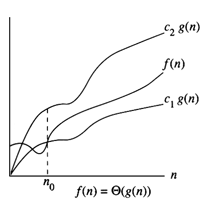Q - Notation:
For a given function g (n) :
Q (g(n)) = { f (n) : $ constants c1, c2,
n0 ³ 0 £ c1 g (n) £
f (n) £ c2 g (n) " n ³ n0
This means: At some point F (n) is sandwiched between c1 g (n) and c2 g (n) :
 from Cormen figure 2.1 from Cormen figure 2.1
Q ( g (n) ) is a set of functions, yet we write " f (n) = Q ( g (n) )" to mean that f (n) Î Q ( g (n) ) We
use set notation because of sandwiching for n ³ f (n) is equal to g (n) to within a constant factor, therefore g (n) is an asymptotically tight bound for f (n).
Note: The definition requires all f (n) Î Q ( g (n) ) to be asymptotically non-negative. This means that g (n) must be as well.
Example Problem:
Show that f (n) = n2/2 - 3n Î Q ( n2 ) -- we must find n0, c1,c2 for this definition that fit the equation:
c1 n2 £ n2/2 - 3n £ c2 n2 " n
³ n0
c1 £ 1/2 - 3/n £ c2 by dividing by n2
If n ³ 1 then 1/2 - 3/n £ 1/2 by making c2 equal to 1/2
1/2 - 3/n ³ 1/14 when n ³ 7 ( 1/2 - 3/n = 0 when n = 6 )
So c1 = 1/14, c2 = 1/2, n0 = 7
Note: other constants work, but we FOUND a set that does.
Consider the contradiction 6 n3 ¹ Q ( n2 ) Suppose this were true:
6 n3 £ c2 n2 " n ³ n0
6 £ c2/n " n ³ n0 then n £ c2/6
A note on condensing expressions: f (n) = an2 + bn + c is Q ( n2 ), in fact:
| P (n ) = |
|
adnd + ....+ a0 -- degree d polynomial is Q ( nd ) |
(proofs are in the text book)
|







